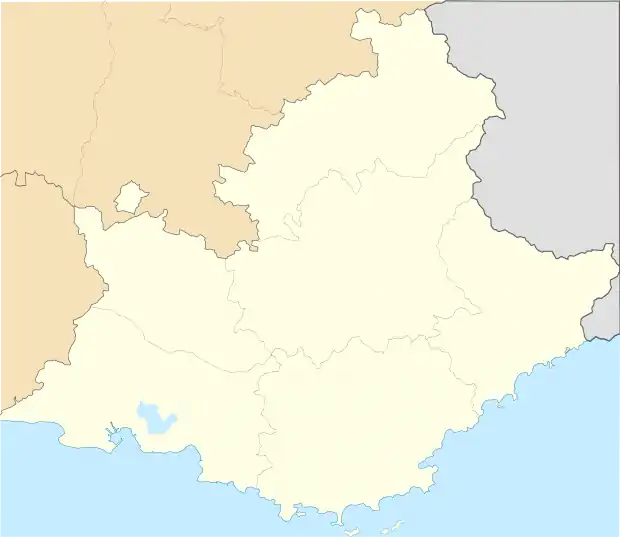Vauvenargues, Bouches-du-Rhône
Vauvenargues (French pronunciation: [vovnaʁg]; Provençal: Vauvenarga) is a commune in the Bouches-du-Rhône department in southern France. It is close to Aix-en-Provence and the Montagne Sainte-Victoire.
Vauvenargues | |
|---|---|
 Vauvenargues castle | |
.svg.png.webp) Coat of arms | |
Location of Vauvenargues 
| |
 Vauvenargues  Vauvenargues | |
| Coordinates: 43°33′20″N 5°36′13″E | |
| Country | France |
| Region | Provence-Alpes-Côte d'Azur |
| Department | Bouches-du-Rhône |
| Arrondissement | Aix-en-Provence |
| Canton | Trets |
| Intercommunality | Aix-Marseille-Provence |
| Government | |
| • Mayor (2020–2026) | Philippe Charrin (PR) |
| Area 1 | 54.31 km2 (20.97 sq mi) |
| Population (2017-01-01)[1] | 1,013 |
| • Density | 19/km2 (48/sq mi) |
| Time zone | UTC+01:00 (CET) |
| • Summer (DST) | UTC+02:00 (CEST) |
| INSEE/Postal code | 13111 /13126 |
| Elevation | 346–1,016 m (1,135–3,333 ft) (avg. 458 m or 1,503 ft) |
| 1 French Land Register data, which excludes lakes, ponds, glaciers > 1 km2 (0.386 sq mi or 247 acres) and river estuaries. | |
Population
| Year | Pop. | ±% |
|---|---|---|
| 1793 | 515 | — |
| 1800 | 448 | −13.0% |
| 1806 | 502 | +12.1% |
| 1821 | 525 | +4.6% |
| 1831 | 512 | −2.5% |
| 1836 | 574 | +12.1% |
| 1841 | 546 | −4.9% |
| 1846 | 518 | −5.1% |
| 1851 | 514 | −0.8% |
| 1856 | 426 | −17.1% |
| 1861 | 429 | +0.7% |
| 1866 | 425 | −0.9% |
| 1872 | 415 | −2.4% |
| 1876 | 386 | −7.0% |
| 1881 | 351 | −9.1% |
| 1886 | 326 | −7.1% |
| 1891 | 275 | −15.6% |
| 1896 | 252 | −8.4% |
| 1901 | 230 | −8.7% |
| 1906 | 223 | −3.0% |
| 1911 | 186 | −16.6% |
| 1921 | 204 | +9.7% |
| 1926 | 185 | −9.3% |
| 1931 | 164 | −11.4% |
| 1936 | 142 | −13.4% |
| 1946 | 161 | +13.4% |
| 1954 | 139 | −13.7% |
| 1962 | 177 | +27.3% |
| 1968 | 271 | +53.1% |
| 1975 | 412 | +52.0% |
| 1982 | 585 | +42.0% |
| 1990 | 674 | +15.2% |
| 1999 | 729 | +8.2% |
| 2008 | 921 | +26.3% |
Chateau of Vauvenargues
The chateau in Vauvenargues stands on the site of a Roman fort which eventually was incorporated in a medieval fortress controlled by the Counts of Provence and later the Archbishops of Aix. For 250 years until the French revolution it was the seat of the de Clapiers family, who rebuilt the chateau in its present form and on whom Louis XV bestowed the title Marquis of Vauvernagues. For 150 years after that it was occupied by the d'Isoard family. In the mid-twentieth century its connection with French nobility lapsed. It was eventually bought in 1958 by Pablo Picasso, who was resident until 1962. Picasso and his wife Jacqueline are buried in the forecourt of the chateau, which is still the private property of the Picasso family.
References
- "Populations légales 2017". INSEE. Retrieved 6 January 2020.